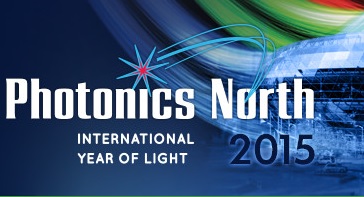Ottawa, Canada (Shaw Centre)
June 10-11, 2015
Optics and photonics technologies are strategic to the overall growth of many industry sectors in Canada; the pervasive nature of these enabling technologies results in novel applications covering numerous fields. To respond to the increasing needs of the industry and population, researchers in optics and photonics from all over the world are developing new capabilities, knowledge and products by transforming research outcomes into innovation with socio-economic impact.
Available software demonstrations:
OptiSystem: Optical Communication System Design Suite
OptiSPICE: Opto-Electronic Circuit Design Software
OptiFDTD: Finite-Difference Time-Domain Software
OptiBPM: Waveguide Optics Design Software
OptiFiber: Optical Fiber Design Software
OptiGrating: Integrated and Fiber Optical Gratings Design Software
| Exhibition Dates |
|
| Wednesday 10 June | 10:00 am to 7:00 pm |
| Thursday 11 June | 10:00 am to 2:00 pm |
| Topics |
|
| Green photonics, energy, and related technologies
Efficient utilization of light, both natural and artificial, is an essential goal of photonics technology. This session investigates photovoltaics and photonics applications in energy efficiency and manufacturing. |
|
| Optical and Quantum communications
The goal of this session is to provide an overview of recent achievements and trends on optical and quantum communications, involving theoretical and experimental advances from the component and device level to the system and network application level. Both short and long-haul communication platforms will be considered. The central interest of the session is on envisioned technologies and strategies aimed at increasing the performance capabilities of available broadband communication platforms. Topics of interest in optical communications include innovative optical multiplexing strategies, such as space-domain multiplexing combined with time-domain or/and frequency-domain multiplexing techniques, advanced optical modulation formats, coherent communication strategies, digital-signal processing methods for pre- and post-compensation of linear and nonlinear impairments, linear and nonlinear photonic technologies for communication applications, such as integrated-waveguide (e.g., silicon photonic) technologies, and network-level strategies for enhanced performance. Concerning quantum communications, though the emphasis is on quantum key distribution, we welcome a diverse range of topics: from components (sources, detectors, memories, repeaters, integrated devices) to systems (fiber-based and free-space), from novel protocols to quantum hacking schemes to quantum measurements. |
|
| Quantum Information with Atoms, Molecules and Photons
Considerable efforts are underway globally to develop quantum processing in different quantum systems. This session investigates various implementations in atoms, molecules, and photons. Traditionally quantum processing has been focussed on quantum communications and computing application. This session will also look at other applications in information processing and sensing. |
|
| Optoelectronics and integrated optics | |
| Photonic materials | |
| Nonlinear optics, nanophotonics and quantum optics
This session aims at giving an overview on recent trends and achievements in nonlinear optics, nanophotonics and quantum optics, with a particular emphasis on fundamental nonlinear radiation-matter interactions, practical applications of nonlinear spectroscopy, deep-subwavelength investigations, nanostructures and nanomaterials for photonics, nanoplasmonic systems, quantum optical communications, quantum cryptography, and integrated quantum optics. We strongly encourage the submission of abstracts that are related to one or more of the above topics. |
|
| Photonic sensors and biomedical optics
Photonic sensors and biomedical optics encompass a range of rapidly advancing technologies. Surface plasmon resonances, micromechanical oscillators, microcavity resonators, fluorescent markers, fiber-optic and optical waveguide techniques, and new in-vivo optical methods are being widely investigated for novel sensing and imaging applications. Theory, simulation, and experiment are combining to produce new capabilities and applications, for example in optofluidics, biosensing, and brain imaging. The ultimate detection limit of some of these new devices can approach the single molecule level, with specificity ensured via chemical functionalization. Photonic sensors can feature multiplexed analysis and are compatible with microfluidics or “lab-on-a-chip” geometries that are enabling the development of small footprint devices. Many new techniques and novel prototypes have been developed in recent years. This session encourages the submission of abstracts relating to all types of optical sensing and biomedical imaging technologies. |
|
| Photonic theory design and simulations
Optical and photonic design and simulation methods and tools are a prerequisite for a fundamental understanding of advanced photonic structures as well as for the development of new optical devices and applications. This can be exemplified by recent advances in diverse areas including nano-structured optical materials, silicon photonics, photonic bandgap engineering, plasmonics, bio-photonics and sensing, communications, optical interconnects, device integration, system level design, and optical network architecture. This session is intended to provide a forum for the interchange of ideas on optics, photonics and optoelectronics theory, design, simulation and verification techniques at different levels, including material properties, components, devices, systems, fabrication, and applications. |
|
| Plasmonics and Metamaterials | |
| High Power Laser technology, ultrafast optics and applications | |


